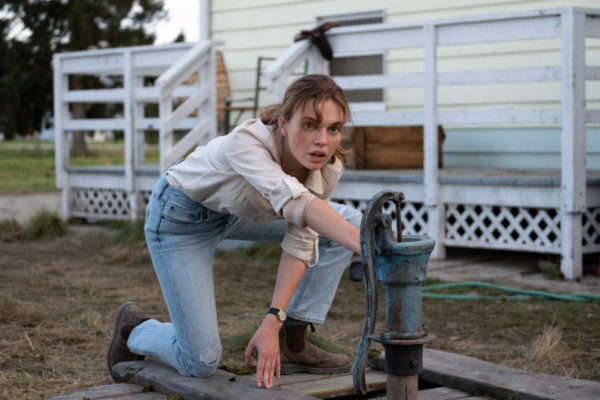
Each week Joe and Terry discuss the most recent episode of CBS All Access’s The Stand, alternating between our respective sites.
Spoilers follow for Episodes 7-9: “The Walk”, “The Stand” and “The Circle Closes”
Missed a Review? Episode 1 / 2 / 3 / 4 / 5 / 6
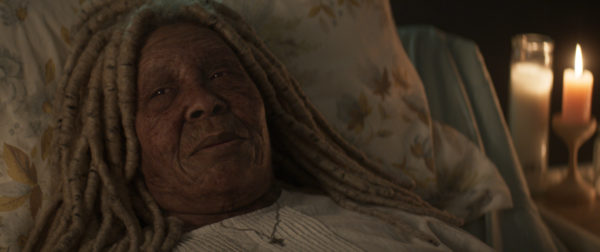
JOE
Well Terry, here we are at the end: the limited series adaptation of Stephen King’s opus, The Stand, has come to a close. But before we tackle the brand new coda from the author himself, let’s briefly touch base on episodes 7 & 8, which we didn’t cover due to commitments with the Sundance Film Fest.
Technically these episodes take us to the end of the source material, starting with Mother Abagail (Whoopi Goldberg) sending four sacrifices acolytes to New Vegas, all the way through to the destruction of the den of sin courtesy of an orb of electricity that zaps virtually all of our antagonists into bloody smithereens when not executing them via silly Rube Goldberg/Final Destination-style kills. Virtually every member of the cast that isn’t named Stu Redman (James Marsden) or Frannie Goldsmith (Odessa Young) expires, including:
- Mother A: dies of natural causes
- Harold (Owen Teague): death by suicide after being impaled on a tree in a road accident
- Nadine (Amber Heard): death by suicide after plummeting out a window into the New Vegas pool
- Glen (Greg Kinnear): shot by Lloyd in a Kangaroo Court
- Lloyd (Nat Wolff): hit in the head with one of the swinging rings above the New Vegas pool
- Julie (Katherine McNamara) / Rat Woman (Fiona Dourif) / Randall Flagg (Alexander Skarsgård): Zapped and exploded by otherworldly electricity
- Larry (Jovan Aepo) / Ray (Irene Bedard) / Trashcan Man (Ezra Miller): blown up in atomic blast
Looking at it in list form, it all seems rather impressive. Sadly, the experience of watching this pair of episodes reflects our overall displeasure with this limited series.
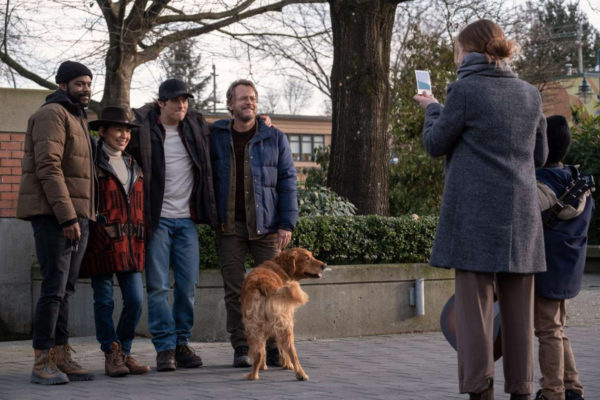
“The Walk” is nearly an hour long, but feels quite a bit longer, because it mostly just features characters just moving between the Boulder Free Zone and New Vegas. “The Stand”, on the other hand, is less than 50 mins and kills nearly the entire cast in what should be the climax of the series (for reference, the final episode is literally titled “coda”).
It’s another in a long line of bizarre decisions from the creative team behind this adaptation. It’s not to say that there aren’t memorable moments or inspired elements in these episodes; but the process of watching this show is tantamount to sifting through garbage looking for the occasional pearl. The Stand has been an exceedingly frustrating viewing experience, Terry (for me, this is the most frustrating experience we’ve covered together aside from Penny Dreadful: City of Angels). Like PD, it’s aggravating because the potential for greatness is there, but never quite grasped.
So let me focus on two elements that I *did* like in these episodes: Nadine and Rat Woman.
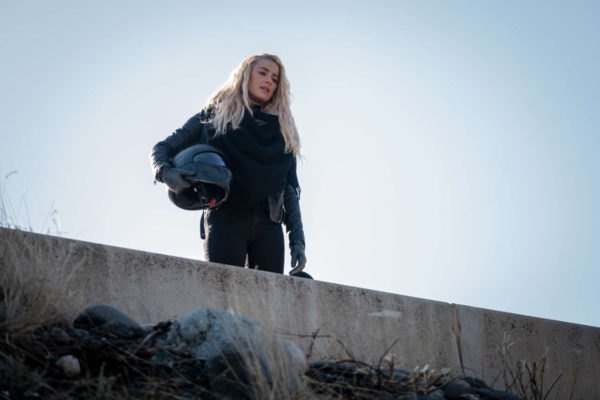
While I will lament that Nadine’s story suffered from hyper acceleration, her manipulation of Harold to remove him from the equation, her seduction by Flagg in the desert sands, her unnatural pregnancy and her demise at her own hand (one final attempt at agency) kept Nadine in the lead as my favourite lead actor on the series.
Would I have rather she got the same drawn-out send-off as Harold? Absolutely!
Would I have liked to sit uncomfortably in her realization that Flagg played her as a vehicle simply to bring his child into the world? 100%
Would I have spoken to the wardrobe department about that atrocious silver wig she sports after she’s deflowered? Jesus, yes (I did, however, like the gaunt, skeletal make-up)
But Nadine is still the character for whom I feel the most pathos. Reflecting back on the fact that she was groomed from childhood, manipulated and lied to throughout her entire life by a false god, Nadine truly is the most sympathetic character in The Stand. And there’s something beautiful in her act of rebellion in the end; her refusal to be used by Flagg, and her long fall (shot beautifully by Canadian genre director Vincenzo Natali) to oblivion.
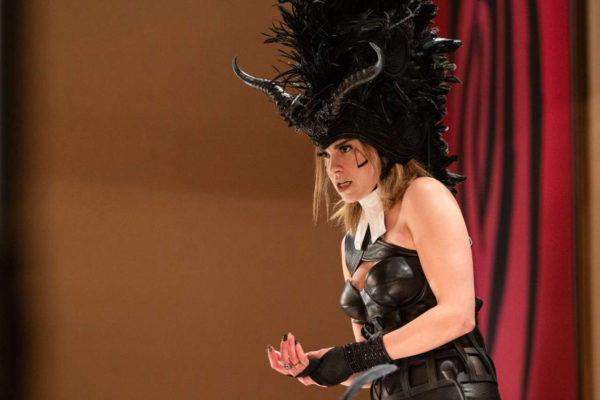
Which brings me to the other side of the coin: Fiona Dourif’s absolutely bonkers portrayal of Rat Woman. So much about episodes 7 and 8 didn’t work for me, Terry, but Dourif’s unhinged pro-Flagg groupie, with her ridiculous outfits and her unbridled enthusiasm, brought me joy. If you’re going to sell the audience on the insanity of worshipping a false god in the city of sin and vice, give it 110%. Dourif does that, in spades and, as a result, the performance is a delight.
Terry, what were your thoughts on episodes 7 & 8? How did you feel they adapted the source material, particularly the “Hand of God”? What are your highs and lows heading into the coda?
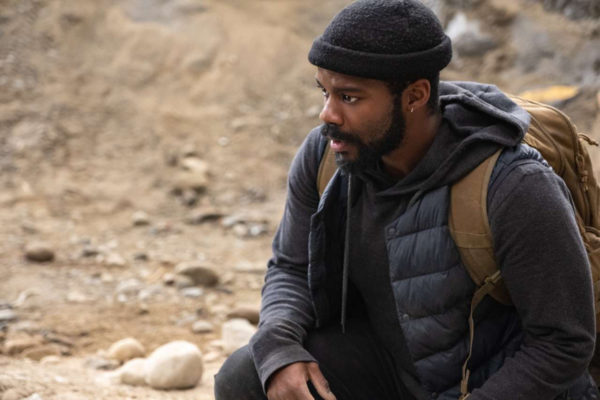
TERRY
Joe, you hit the nail on the head: outside of our discussion and eventual exiting out of Lovecraft Country over its use of queer characters, this is the most frustrating and agonizing series we’ve covered in the last two-ish years. It’s even more upsetting to me because of my love of the source material (and Stephen King, in general).
I went into The Stand positively beaming at the possibilities of seeing the book translated to screen and now I’m exiting it with a perplexed look on my face as I stare dumbfounded at the television screen. Episodes 7 and 8 are actually, in this way, a perfect summation of the series as a whole. As you alluded to above, moments of inspired filmmaking are surrounded by trash.
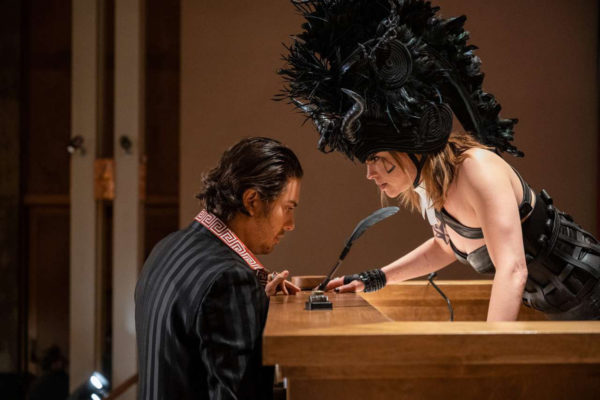
Let’s take Fiona Dourif’s inspired casting. Did you know that she’s actually been in four episodes of the series? While she’s given a lot to do in these final moments and truly shine, she was actually in all of the Las Vegas-set episodes casually hanging out in the background; another reminder of the talent on display that gets summarily wasted. I knew she was in the series and I kept thinking I saw her but it wasn’t until we actually spend time with her that I realized the character I’ve been watching was her.
On the high side, episode 8 “The Stand” really showed the kind of energy and excitement that (most of) the previous seven episodes lacked…mostly thanks, I think, to Natali (Splice, In the Tall Grass). The energy humming through “The Stand” felt as electric as the thunderous lightning bolts that disintegrated–Fright Night remake-style–the denizens of the literal and figurative Sin City. Also electric was Amber Heard’s performance, particularly in this episode, and you’re absolutely right on her final moment of agency.

What I love about this is that it’s one of the few times the show has diverged from the book’s plot. In King’s story, she comes to a realization that she’s been used and begins to goad Flagg until he loses it and throws her from the tower. Here, she actually has the agency to stop him in his tracks. It’s a small change, but a nice one.
Then to have Flagg serve up her smashed face to Larry was not only a fantastic special effect of a middle finger, but also a hilariously dark one. It’s a tone that’s been missing from the series as a whole and it was nice to see The Stand embrace some of its own brand of lunacy. The humor continues as Larry and Ray are chained at the bottom of the pool and while they’re awaiting their demise, “Heaven” by U96 plays and Flagg starts dancing as if he’s in a gay club. It’s a divine moment that further showed how joyless this series has been.
On the negative side…boy, the BIPOC main cast really gets fucked here.
In episode 6, we lost Nick (Henry Zaga). In episode 7, we lost Mother Abagail. Then episode 8 depicts the abuse, near drowning and eventual disintegration of Larry and Ray…while Stu and Tom Cullen (Brad William Henke) presumably survive.
While I’m happy they went with a Black actor to play Larry (Adam Storke played him in the original mini-series) and not only gender-swapped Ray but cast an Indigeonous actress as her (Peter Van Norden played “Ralph” Brentner in the original), it adds a troubling layer to the narrative. It further solidifies the fact that the white main characters represented by Tom, Stu and Frannie live on.
Oof.
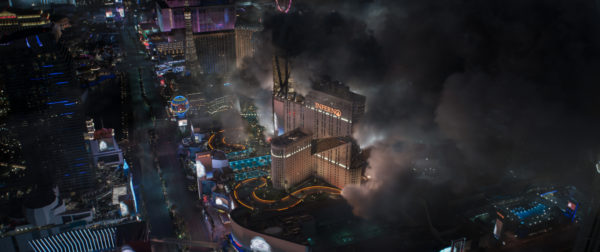
I also started to realize just how much of a troll this adaptation’s representation of “God” is. A being that forces his sacrificial goats to walk–with only the clothes they have–the 800+ miles to Las Vegas. A being that then just…electrocutes the bad guys and seems to push the bomb as almost an afterthought.
What I find hilarious is that 1) it doesn’t matter where in Las Vegas Trashcan Man brought the nuclear bomb…detonating it reduces the whole city to ash and 2) the bomb truly wasn’t even needed because everyone was already disintegrated by the (beautifully shot) lightning storm. What was the purpose? For the four Lone Rangers to put their faith, however shakily in him, in order fo him to destroy the evil? Talk about trollish behavior.
And with the gigantic explosion leaving our small, white main cast alone, we turn to the reason we continued our reviews, Joe. We’ve reached the end and I have to know…does “The Circle Closes” see us ending on a positive note? Or are we evaporated like the City of Sin itself?

JOE
Well, let’s unpack this final subdued hour, Terry. What we see is pretty much exactly what the original finale title – “Coda: Frannie in the Well” – promised: it’s a pretty bare bones finale that puts a pin on life in Boulder in favour of following Frannie and Stu and baby Abagail on the road. It’s a quiet hour, but it also never truly escapes the feeling that this is tacked-on piece that isn’t really necessary. If I’m being blunt, this feels more like an excuse to bring King onboard the series as a writer, and as a result it never really justifies its own existence.
Perhaps it’s because I wasn’t invested in Frannie’s final test by Randall Flagg, but I wound up fixating on the episode’s treatment of its Indigenous characters. A better part of the episode consists of Flagg reanimating in Frannie’s (un)consciousness in order to test her moral compass.
This is fine, but the visual treatment involves using a tribe untouched by civilization as an allegorical counterpart for the more “advanced” world that was destroyed by Captain Tripps. Narratively it makes sense: these people are living their lives, having never been perverted by the kind of technology and greed that Frannie worries will consume the new world once again.
So yeah, I get that. BUT it also codifies these people as “primitive” and simple. This tribe of people aren’t characters; they’re ciphers for white characters to use in their philosophical arguments about good and evil.
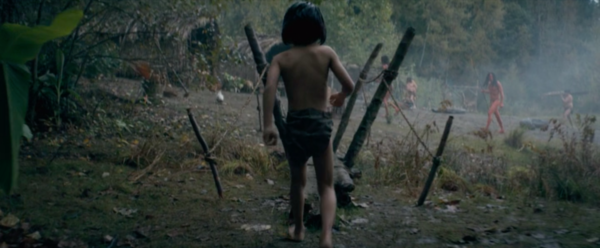
I wound up having a conversation offline with Michael Roffman of The Losers Club and he helped me to see it more as the series’ way of highlighting that Flagg, who renames himself Russell Faraday, is an eternal force and that the forces of evil can never truly be defeated. I can 100% see that: King has always been interested in narratives that reinforce the sustainability of both good and bad in both the world and the hearts of men.
BUT (again!) not unlike our discussion from Lovecraft Country, I find the overly simplified use of Indigenous people as a narrative shortcut pretty galling, verging on offensive.

As someone who has repeatedly seen white settler culture appropriate not just Indigenous culture, but discount their longevity, complexity and power, these scenes really pissed me off. Reading your section above, it’s evident that Boone’s The Stand tried to be more diverse with its casting, but time and time again the show failed its BIPOC characters – both in terms of narrative and characterization.
Even here, in its final hour, King can’t help himself from falling back on the Magical Negro trope with its ressurected-in-the-body-of-a-child Mother A figure. It’s shitty, and it ends the series on a particularly bad note. It’s the final nail in the coffin of this poorly handled limited series, which I rate C- overall.
Terry, did you have the same kind of response? Did you find the streamlined, pared down focus on Frannie and Stu appealing? And what’s your final grade for the series?
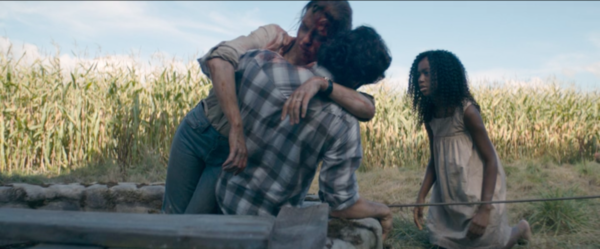
TERRY
What is there left to say, Joe? I think you pretty much covered it above in a lot of ways. This nugget of an episode felt, in some ways, like Stephen King Constant Reader fan service, and was deeply moralizing in a way that I found vaguely insulting. I’ve always maintained that Stephen King is a better writer than he is a screenwriter and this finale pretty much proved that for me.
I remember back when Whoopi Goldberg was going on the press circuit after she was cast as Abagail, she maintained that this version of the character would not fall into the Magical Negro trap that the novel and the original adaptation did. She said the character couldn’t be a trope and that “That was fine 40 years ago, but she had to be a real person.”
And yet here we are, with the young girl version of Abagail stitching Frannie back together again and bringing her back to life. Her only purpose in this entry is to reward Frannie for not giving into temptation and to be the deus ex little girl who saves the day from Flagg.
Speaking of the temptation,“The Circle Closes” fully committed to the Biblical ideals that the series had played around with from the beginning. Frannie’s unconscious mind is taken to an Eden-like location, unspoiled by mankind, and she and Stu basically become the modern interpretation of Adam and Eve. Her struggle in the jungle with Flagg is Eve and the serpent, the forbidden fruit becomes a kiss and the promise that evil will continue through her. It’s a bit on the nose, even before Frannie colorfully shouts, “get thee behind me, you fucking bastard.”
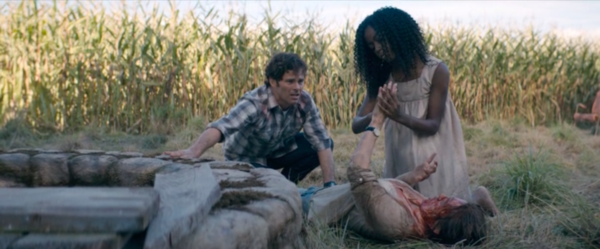
Her ability to renounce Flagg’s evil further cements her sterling image as a new proto-Eve; one who bests the serpent. At one point, Abagail even mentions that she will have five kids and those kids will have twenty, and then those kids will have seventy. “Your children will replenish the earth,” she says. And it’s hard not to see that and the very whiteness of the characters and not be skeeved out by the implication.
Obviously that’s simplifying things because the Denver Free Zone (and presumably other places throughout the world) are more representative of the multicultural world and will also replenish the earth. But the image we’re left with is two beautiful white people repopulating the world.
And when it’s not moralizing about this eternal struggle and equating it to Christian values, the finale attempts to tie into the larger King world as a whole. The idea of “the wheel turns” is meant to draw further parallels between The Stand and The Dark Tower and its famous statement that “Ka was like a wheel, its one purpose to turn, and in the end it always came back to the place where it had started.”
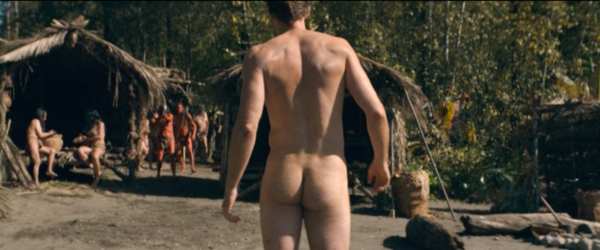
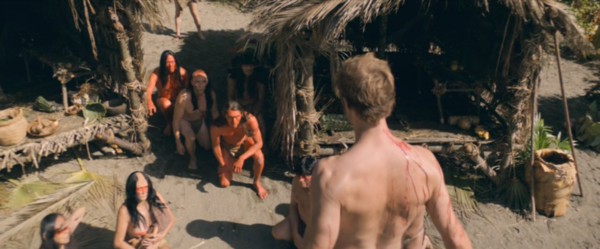
So we’re at the final scene where Flagg walks, naked ass jiggling, into the Indigenous camp. And yes, you’re absolutely right with everything you said. As Michael Roffman implied, it’s meant to evoke the concept of the wheel: it exists, regardless of Good or Evil, and it will keep turning.
It’s more or less the way The Stand: Complete and Uncut (the 1990 re-release of the novel) ended. It’s meant to suggest that Evil will always exist and try to find new places to grow and spread. But that doesn’t excuse the way the Indigenous people are presented as “simple” compared to the “complex” modern world. I literally rolled my eyes (even though the final burst of gore was surprisingly gnarly).
Joe, I’m probably not going to be as kind as you with my rating. I’ve said this multiple times but The Stand is one of my favorites of King’s novels because of the amount of time spent on the characters. I’ve always been more attracted to the people King creates and the conflicts he forces them into than the overarching plot, so I could look past the iffy moralizing and the traditional take of the Capital Good and Capital Evil story that feels overly simplistic now.
Because I would remember Nadine.
Joe.
Larry.
Their struggles. Their successes and their failures.
It was the little moments. And those things were completely missing from this limited series.
How so many people who profess to love King (or, sadly enough, even King himself) didn’t understand what The Stand was truly about is beyond me. But this adaptation was dead in the water. It’s a D+ for me.